#U.S. Embassy Operations
Explore tagged Tumblr posts
Text
The Future of U.S. Embassy Operations Under Project 2025: A Critical Perspective
Project 2025 outlines a transformative vision for U.S. embassy operations, aiming to streamline diplomatic missions, increase efficiency, and align embassy roles more directly with U.S. foreign policy goals. While the plan seeks to modernize embassy functions and reduce operational costs, critics argue that the proposed changes could compromise the diplomatic effectiveness, flexibility, and local…

View On WordPress
#Diplomatic Strategy Reform#Embassy Policy Overhaul#Embassy Workforce Challenges#Future of U.S. Diplomacy#International Relations Impact#Project 2025 Critiques#U.S. Embassy Operations
0 notes
Text
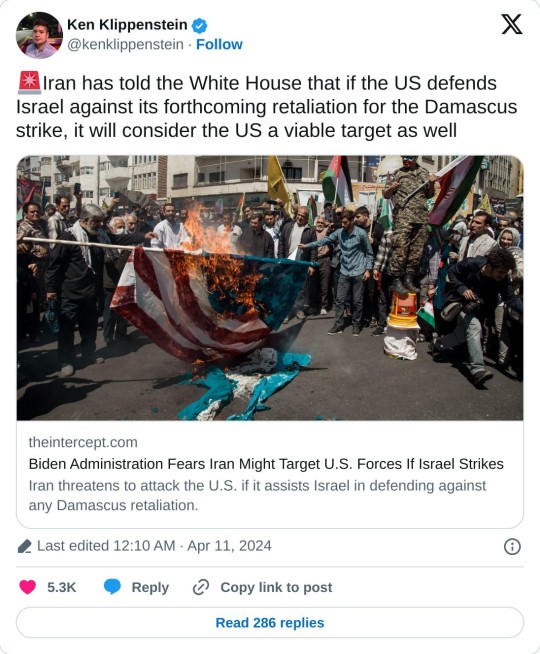
THE WHITE HOUSE is worried that Iran might strike a U.S. target as part of a potential retaliation for Israel’s April 1 attack on its embassy in Damascus, Syria, according to notes from a meeting involving National Security Council officials earlier this week. Tehran has vowed that “Israel will be punished” for the Syria strike and the killing of Quds Force commander Mohammad Reza Zahedi. New concern about a potential Iranian strike comes even though the Biden administration has sought to distance itself from the Israeli airstrike, stressing that it had no advance knowledge of the operation. “I don’t have anything more to say about the strike in Damascus, except that we weren’t involved in any way whatsoever,” NSC spokesperson retired Adm. John Kirby said on Monday. On Monday night, Iran conveyed to the Biden administration that if it involved itself in defending Israel were Tehran to undertake a retaliatory strike, it would consider the United States a viable target as well. The issue was discussed at a Tuesday NSC meeting, according to notes reviewed by The Intercept. (The NSC did not respond to a request for comment.)
Since then, the U.S. has quietly conducted talks with Iranian officials to seek to avoid direct confrontation between the two countries’ armed forces, according to CNN and other media reports. On Sunday, Senate Majority Leader Chuck Schumer said that Biden and his team are working to prevent escalation with Iran in the Middle East. On Wednesday, Iran’s Supreme Leader Ayatollah Ali Khamenei said that Israel “must be punished and it shall be.” That same day, Israeli Foreign Affairs Minister Israel Katz said his country would respond with a direct attack. “If Iran attacks from its own territory, Israel will respond and attack in Iran,” Katz posted on X. Since April 2023, the U.S. and Israel have been in close cooperation in sharing and building common Iran contingency plans.
#yemen#jerusalem#tel aviv#current events#palestine#free palestine#gaza#free gaza#news on gaza#palestine news#news update#war news#war on gaza#iran#regional war#biden administration
1K notes
·
View notes
Text
I have long been interested in the resonances between the Nakba and the Maafa – this is the Swahili word chosen for what is otherwise dubbed the “Middle Passage” in the history of African enslavement in the Americas, in North America specifically in this case. Both terms translate to the same thing: disaster or catastrophe. Both are used for enormous dislocating experiences that go on to define ongoing lives of struggle. Whenever I hear “Nakba,” I think immediately Maafa. There is a need to insist on these terms in these languages because, as the argument goes, there is no way that the language of the colonizer – the language of the criminal who criminalizes us – can adequately express the experience of this crime, a crime against humanity, our humanity, and a crime against history. The Nakba was a presence in the overwhelming majority of my interviews with Palestinian former prisoners (who might become prisoners anew at any time, we must add). I would begin by asking where they were from to find out who they are and how they began their lives in the revolutionary struggle. They would often narrate their histories in terms of origin in a now “far” place, followed by displacement around 1948. Each micro-autobiography was also a Nakba story, about families scattered and how people came to end up in Ramallah or Hebron from Haifa or Jaffa. It may be helpful as well then to think of the ongoing Nakba as part of a regime of captivity, and not only as dispossession and expulsion, as it is commonly discussed by other academic perspectives in particular. This is no dichotomy. A focus on captivity could nonetheless highlight Zionism’s ongoing attempts at controlling Palestinians, not to mention others, “here and there.” In the context of apartheid in South Africa or Jim Crow in the US, people often think the term “segregation” accurately identified what was going on. But this is misleading – there was never really “segregation” by any name in those cases. There was always a line that the colonizer could cross when he saw fit for purposes of economic or sexual exploitation or any other reason and that the colonized couldn’t cross without facing murderous violence. The “separations” of “Apartheid” are breached in and out of colonial interests, as a rule. Similarly, when we think of the Nakba it is very much about removing Palestinians from land as well as controlling and containing them at whatever remove at the same time—in Gaza, in the West Bank, in the diaspora beyond. Look at the assassination of the escaped prisoner Omar Zayed, who was newly captive in seeking refuge in the Palestinian embassy in Sofia, Bulgaria. Also, one former prisoner whom I interviewed in Majd El Kurum described that village as “a West Bank-style refugee camp” in ’48 Palestine. We could talk about how gentrification operates like this in Palestine and the U.S. with all its attendant policing and state violence. Like Malcolm X said, a long time ago now, this is very much about the power of control and containment in the bloody occupation of land, wherever you are or end up – all limiting terminology aside.
—Professor Greg Thomas for the Nakba Files, “Palestine in the Sun of the Black Radical Tradition”
#it speaks!#i don't have time tonight to finish my post on solidarity between Black and Palestinian resistance art but this is necessary reading#greg thomas#palestine#colonialism#antiblackness#also for the first point:#in translation#now reading
102 notes
·
View notes
Text
Russia has intensified cyber operations against Ukraine and NATO countries, according to previous U.S. intelligence and private sector reports.
March 2, 2025, 6:35 PM MST
By Courtney Kube and Nnamdi Egwuonwu
Defense Secretary Pete Hegseth has ordered U.S. Cyber Command to halt offensive cyber operations and information operations against Russia, a U.S. official familiar with the matter said.
Hegseth gave the order to the head of the command, Air Force Gen. Tim Haugh, in late February, the official said. It is unclear clear how long the order will last.
A senior U.S. defense official declined to comment on the decision "due to operational security concerns."
“There is no greater priority to Secretary Hegseth than the safety of the Warfighter in all operations, to include the cyber domain,” the official told NBC News.
The U.S. Cybersecurity and Infrastructure Security Agency, which is housed in the Department of Homeland Security, said in a statement that its "mission is to defend against all cyber threats to U.S. Critical Infrastructure, including from Russia. There has been no change in our posture."
Representatives for U.S. Cyber Command did not immediately respond to a request for comment. The Russian Embassy also did not immediately reply to a request for comment.
114 notes
·
View notes
Text
The Guardian:
Donald Trump said on Monday he would sign an executive order imposing a 25% tariff on all products coming in to the United States from Mexico and Canada, and additional tariffs on China.
“On January 20th, as one of my many first Executive Orders, I will sign all necessary documents to charge Mexico and Canada a 25% Tariff on ALL products coming into the United States, and its ridiculous Open Borders,” Trump said in a post on Truth Social. Trump said the tariffs would remain in place until the two countries clamp down on drugs, particularly fentanyl, and migrants crossing the border illegally. In a follow-up post, Trump announced that the US “will be charging China an additional 10% Tariff, above any additional Tariffs, on all of their many products coming into the United States of America”. He said that the reason for the additional tariff was China’s failure to curb the number of drugs entering the US. China is a major producer of precursor chemicals that are acquired by drug cartels, including in Mexico, to manufacture fentanyl, a highly potent synthetic opioid. “I have had many talks with China about the massive amounts of drugs, in particular Fentanyl, being sent into the United States – But to no avail … Until such time as they stop, we will be charging China an additional 10% Tariff, above any additional Tariffs, on all of their many products coming into the United States of America.” In response, China warned that “no one will win a trade war”.
Liu Pengyu, a Chinese embassy spokesperson, said China had taken steps to combat drug trafficking after an agreement was reached last year between Joe Biden and Xi Jinping. “The Chinese side has notified the US side of the progress made in US-related law enforcement operations against narcotics,” he said in a statement. “All these prove that the idea of China knowingly allowing fentanyl precursors to flow into the United States runs completely counter to facts and reality.” Canada’s deputy prime minister, Chrystia Freeland, released a statement on Monday evening saying that the country places the highest priority on border security and the integrity of its shared border with the US. Trump and Canadian prime minister Justin Trudeau spoke on Monday night about trade and border security, Reuters reported, citing a Canadian source directly familiar with the situation. Freeland’s statement did not mention the tariffs directly. It also said that the Canada Border Services Agency, the US Drug Enforcement Administration and US Customs and Border protection “work together every single day to to disrupt the scourge of fentanyl coming from China and other countries.”
[...] A tariff is a tax placed on goods when they cross national borders. Import tariffs such as those proposed by Trump can have the effect of protecting domestic industries from foreign competition while also generating tax revenue for the government. But economists widely consider them an inefficient tool that typically leaves consumers and taxpayers bearing the brunt of higher costs.
Donald Trump vows to enact economy-crushing 25% tariffs on fellow USMCA members Mexico and Canada, and much steeper tariffs on China.
See Also:
HuffPost: Trump Says U.S. Will Impose Massive Tariffs On Mexico, Canada And China From Day 1
55 notes
·
View notes
Text
More than half of Iran’s weapons were destroyed by U.S. aircraft and missiles before they ever reached Israel. In fact, by commanding a multinational air defense operation and scrambling American fighter jets, this was a U.S. military triumph. The extent of the U.S. military operation is unbeknownst to the American public, but the Pentagon coordinated a multination, regionwide defense extending from northern Iraq to the southern Persian Gulf on Saturday. During the operation, the U.S., U.K., France, and Jordan all shot down the majority of Iranian drones and missiles. In fact, where U.S. aircraft originated from has not been officially announced, an omission that has been repeated by the mainstream media. Additionally, the role of Saudi Arabia is unclear, both as a base for the United States and in terms of any actions by the Saudi military.
[...]
Israel’s statement that it shot down the majority of Iranian “cruise missiles” is probably an exaggeration. According to U.S. military sources and preliminary reporting, U.S. and allied aircraft shot down the majority of drones and cruise missiles. U.K. Prime Minister Rishi Sunak said that the Royal Air Force Typhoons intercepted “a number” of Iranian weapons over Iraqi and Syrian airspace. The Jordanian government has also hinted that its aircraft downed some Iranian weapons. “We will intercept every drone or missile that violates Jordan’s airspace to avert any danger. Anything posing a threat to Jordan and the security of Jordanians, we will confront it with all our capabilities and resources,” Jordan’s Foreign Minister Ayman Safadi said during an interview on the Al-Mamlaka news channel. French fighters also shot down some drones and possibly cruise missiles.
174 notes
·
View notes
Text

What a front cover...
* * * *
LETTERS FROM AN AMERICAN
March 6, 2025
Heather Cox Richardson
Mar 07, 2025
This morning, Ted Hesson and Kristina Cooke of Reuters reported that the Trump administration is preparing to deport the 240,000 Ukrainians who fled Russia’s attacks on Ukraine and have temporary legal status in the United States. Foreign affairs journalist Olga Nesterova reminded Americans that “these people had to be completely financially independent, pay tax, pay all fees (around $2K) and have an affidavit from an American person to even come here.”
“This has nothing to do with strategic necessity or geopolitics,” Russia specialist Tom Nichols posted. “This is just cruelty to show [Russian president Vladimir] Putin he has a new American ally.”
The Trump administration’s turn away from traditional European alliances and toward Russia will have profound effects on U.S. standing in the world. Edward Wong and Mark Mazzetti reported in the New York Times today that senior officials in the State Department are making plans to close a dozen consulates, mostly in Western Europe, including consulates in Florence, Italy; Strasbourg, France; Hamburg, Germany; and Ponta Delgada, Portugal, as well as a consulate in Brazil and another in Turkey.
In late February, Nahal Toosi reported in Politico that President Donald Trump wants to “radically shrink” the State Department and to change its mission from diplomacy and soft power initiatives that advance democracy and human rights to focusing on transactional agreements with other governments and promoting foreign investment in the U.S.
Elon Musk and the “Department of Government Efficiency” have taken on the process of cutting the State Department budget by as much as 20%, and cutting at least some of the department’s 80,000 employees. As part of that project, DOGE’s Edward Coristine, known publicly as “Big Balls,” is embedded at the State Department.
As the U.S. retreats from its engagement with the world, China has been working to forge greater ties. China now has more global diplomatic posts than the U.S. and plays a stronger role in international organizations. Already in 2025, about 700 employees, including 450 career diplomats, have resigned from the State Department, a number that normally would reflect a year’s resignations.
Shutting embassies will hamper not just the process of fostering goodwill, but also U.S. intelligence, as embassies house officers who monitor terrorism, infectious disease, trade, commerce, militaries, and government, including those from the intelligence community. U.S. intelligence has always been formidable, but the administration appears to be weakening it.
As predicted, Trump’s turn of the U.S. toward Russia also means that allies are concerned he or members of his administration will share classified intelligence with Russia, thus exposing the identities of their operatives. They are considering new protocols for sharing information with the United States. The Five Eyes alliance between Australia, Canada, New Zealand, the United Kingdom and the U.S. has been formidable since World War II and has been key to countering first the Soviet Union and then Russia. Allied governments are now considering withholding information about sources or analyses from the U.S.
Their concern is likely heightened by the return to Trump’s personal possession of the boxes of documents containing classified information the FBI recovered in August 2022 from Mar-a-Lago. Trump took those boxes back from the Department of Justice and flew them back to Mar-a-Lago on February 28.
A CBS News/YouGov poll from February 26–28 showed that only 4% of the American people sided with Russia in its ongoing war with Ukraine.
The unpopularity of the new administration's policies is starting to show. National Republican Congressional Committee chair Richard Hudson (R-NC) told House Republicans on Tuesday to stop holding town halls after several such events have turned raucous as attendees complained about the course of the Trump administration. Trump has blamed paid “troublemakers” for the agitation, and claimed the disruptions are part of the Democrats’ “game.” “[B]ut just like our big LANDSLIDE ELECTION,” he posted on social media, “it’s not going to work for them!”
More Americans voted for someone other than Trump than voted for him.
Even aside from the angry protests, DOGE is running into trouble. In his speech before a joint session of Congress on Tuesday, Trump referred to DOGE and said it “is headed by Elon Musk, who is in the gallery tonight.” In a filing in a lawsuit against DOGE and Musk, the White House declared that Musk is neither in charge of DOGE nor an employee of it. When pressed, the White House claimed on February 26 that the acting administrator of DOGE is staffer Amy Gleason. Immediately after Trump’s statement, the plaintiffs in that case asked permission to add Trump’s statement to their lawsuit.
Musk has claimed to have found billions of dollars of waste or fraud in the government, and Trump and the White House have touted those statements. But their claims to have found massive savings have been full of errors, and most of their claims have been disproved. DOGE has already had to retract five of its seven biggest claims. As for “savings,” the government spent about $710 billion in the first month of Trump’s term, compared with about $630 billion during the same timeframe last year.
Instead of showing great savings, DOGE’s claims reveal just how poorly Musk and his team understand the work of the federal government. After forcing employees out of their positions, they have had to hire back individuals who are, in fact, crucial to the nation, including the people guarding the U.S. nuclear stockpile. In his Tuesday speech, Trump claimed that the DOGE team had found “$8 million for making mice transgender,” and added: “This is real.”
Except it’s not. The mice in question were not “transgender”; they were “transgenic,” which means they are genetically altered for use in scientific experiments to learn more about human health. For comparison, S.V. Date noted in HuffPost that in just his first month in office, Trump spent about $10.7 million in taxpayer money playing golf.
Josh Marshall of Talking Points Memo pointed out today that people reporting on the individual cuts to U.S. scientific and health-related grants are missing the larger picture: “DOGE and Donald Trump are trying to shut down advanced medical research, especially cancer research, in the United States…. They’re shutting down medicine/disease research in the federal government and the government-run and funded ecosystem of funding for most research throughout the United States. It’s not hyperbole. That’s happening.”
Republicans are starting to express some concern about Musk and DOGE. As soon as Trump took office, Musk and his DOGE team took over the Office of Personnel Management, and by February 14 they had begun a massive purge of federal workers. As protests of the cuts began, Trump urged Musk on February 22 to be “more aggressive” in cutting the government, prompting Musk to demand that all federal employees explain what they had accomplished in the past week under threat of firing. That request sparked a struggle in the executive branch as cabinet officers told the employees in their departments to ignore Musk. Then, on February 27, U.S. District Judge William Alsup found that the firings were likely illegal and temporarily halted them.
On Tuesday, Senate majority leader John Thune (R-SD) weighed in on the conflict when he told CNN that the power to hire and fire employees properly belongs to Cabinet secretaries.
Yesterday, Musk met with Republican— but no Democratic— members of Congress. Senators reportedly asked Musk—an unelected bureaucrat whose actions are likely illegal—to tell them more about what’s going on. According to Liz Goodwin, Marianna Sotomayor, and Theodoric Meyer of the Washington Post, Musk gave some of the senators his phone number and said he wanted to set up a direct line for them when they have questions, allowing them to get a near-instant response to their concerns.” Senator Lindsey Graham (R-SC) told reporters that Musk told the senators he would “create a system where members of Congress can call some central group” to get cuts they dislike reversed.
This whole exchange is bonkers. The Constitution gives Congress alone the power to make appropriations and pass the laws that decide how money is spent. Josh Marshall asks: “How on earth are we in this position where members of Congress, the ones who write the budget, appropriate and assign the money, now have to go hat in hand to beg for changes or even information from the guy who actually seems to be running the government?”
Later, Musk met with House Republicans and offered to set up a similar way for the members of the House Oversight DOGE Subcommittee to reach him. When representatives complained about the random cuts that were so upsetting constituents. Musk defended DOGE’s mistakes by saying that he “can’t bat a thousand all the time.”
This morning, U.S. District Judge John McConnell Jr. ruled in favor of a group of state attorneys general from 22 Democratic states and the District of Columbia, saying that Trump does not have the authority to freeze funding appropriated by Congress. McConnell wrote that the spending freeze "fundamentally undermines the distinct constitutional roles of each branch of our government." As Joyce White Vance explained in Civil Discourse, McConnell issued a preliminary injunction that will stay in place until the case, called New York v. Trump, works its way through the courts. The injunction applies only in the states that sued, though, leaving Republican-dominated states out in the cold.
Today, Trump convened his cabinet and, with Musk present, told the secretaries that they, and not Musk, are in charge of their departments. Dasha Burns and Kyle Cheney of Politico reported that Trump told the secretaries that Musk only has the power to make recommendations, not to make staffing or policy decisions.
Trump is also apparently feeling pressure over his tariffs of 25% on goods from Canada and Mexico and an additional 10% on imports from China that went into effect on Tuesday, which economists warned would create inflation and cut economic growth. Today, Trump first said he would exempt car and truck parts from the tariffs, then expanded exemptions to include goods covered by the U.S.-Mexico-Canada trade agreement (USMCA) Trump signed in his first term. Administration officials say other tariffs will go into effect at different times in the future.
The stock market has dropped dramatically over the past three days owing to both the tariffs and the uncertainty over their implementation. But Trump denied his abrupt change had anything to do with the stock market.
“I’m not even looking at the market,” Trump said, “because long term, the United States will be very strong with what’s happening.”
LETTERS FROM AN AMERICAN
HEATHER COX RICHARDSON
#Letters From an American#Heather Cox Richardson#the Stock Market#economic outlook#USMCA#trade#U.S.-Mexico-Canada trade agreement#tariffs#misinformation#war in ukraine#the lying administration#the lying cabinet
31 notes
·
View notes
Text
Unrolled twitter thread by Progressive International (@ProgIntl)
30 Sept 24 • 4 minute read • Read on X
On 30 September 1965, the Indonesian military, working closely with the US government, initiated a coup that would depose President Sukarno and install the brutal, 30-year dictatorship of General Suharto.

In the dark years that followed, the dictatorship massacred over a million Indonesian communists, with the CIA and US diplomats drawing up “kill lists” for the Indonesian military. The operation would become a template for the US’s regime change operations for decades to come.

Major-General Suharto with Indonesian Army in 1966
In 1945, President Sukarno led Indonesia to independence from Dutch colonial rule. He championed the Non-Aligned Movement and hosted the historic Bandung Conference, a meeting of Afro-Asian states, in 1955.
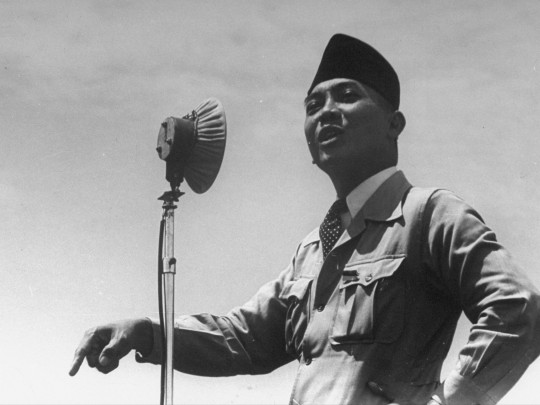
First President of Indonesia Sukarno making a speech circa 1945
Opening the conference and forecasting what was to come, Sukarno said: “We are often told ‘Colonialism is dead’. Let us not be deceived or even soothed by that… Colonialism also has its modern dress, in the form of economic control, intellectual control, actual physical control by a small, but alien community within a nation.”
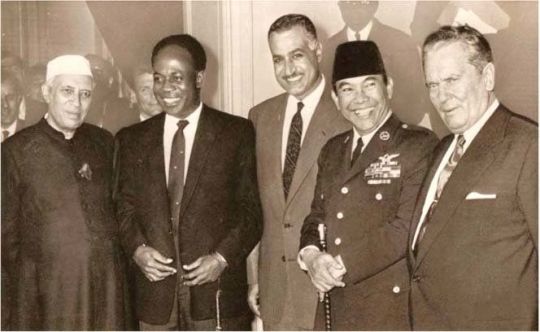
Leaders attending the Bandung Conference 1955 in Bandung, Indonesia. From left: Indian Prime Minister Jawaharlal Nehru, Ghanian Prime Minister Kwame Nkrumah, Egyptian Prime Minister Gamal Abdel Nasser, President Sukarno, and Yugoslavian Prime Minister Josip Broz Tito.
By 1965, Indonesia possessed one of the world's largest communist parties, the PKI. The PKI had a mass membership and mobilized vast numbers of people in the battle against Indonesia’s ruling class.

Campaign of the Indonesian Communist Party (PKI) in September 1955.
Terrified by the strength and organization of Indonesia’s people, the Indonesian military’s 30th September Movement began to purge the PKI.
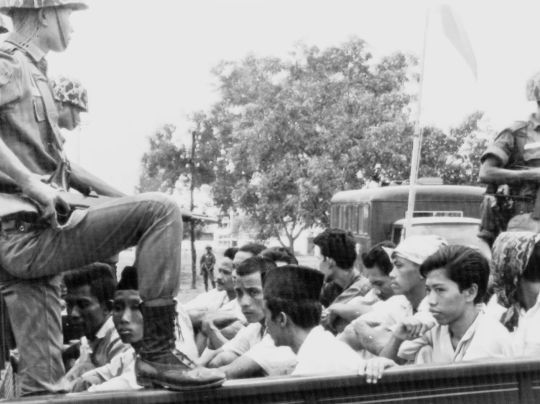
Men suspected of being IPK members being transported under guard by an armed Indonesian soldier
In the early hours of 1 October, a group of military conscripts murdered six high-ranking generals. Blaming the deaths on the PKI, Suharto used the attacks as a pretext to seize power. CIA communications equipment allowed him to spread false reports around the country and begin a long campaign of anti-communist propaganda.
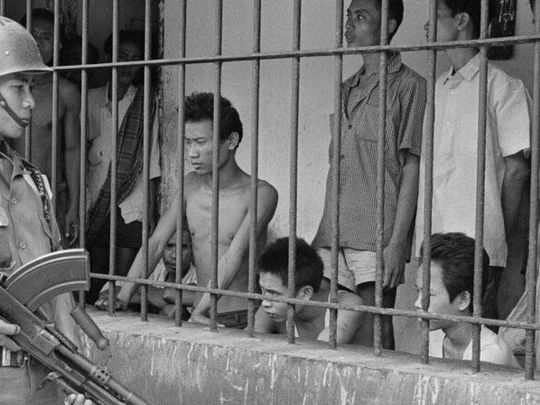
The US had tried to overthrow Sukarno for years; in 1958, the CIA backed armed regional rebellions against the central government. In 1965, they did all they could to aid Suharto’s murderous power grab.
The campaign soon became genocidal. On islands like Bali, up to 10% of the population was massacred — and luxury hotels soon began to appear over the killing fields.
One US embassy staffer told the US press that Suharto’s military “probably killed a lot of people, and I probably have a lot of blood on my hands, but that's not all bad.”
Time Magazine referred to the killings as “the West’s best news for years in Asia”.

A cable from the US embassy’s first secretary, Mary Vance Trent, to the State Department referred to events in Indonesia as a “fantastic switch which has occurred over 10 short weeks”. It also included an estimate that 100,000 people had been slaughtered.
Cementing his power, Suharto became president in 1967. His ‘New Order’ policy allowed Western capitalism to exploit Indonesia’s cheap labour and plunder its natural resources. Civil rights and dissent were suppressed.
In one of the world’s most populous countries, any possibility for the emergence of a new, democratic political project was eliminated. Richard Nixon described Indonesia as “the greatest prize in Southeast Asia”. Suharto would not leave office until 1998.

U.S. President Ronald Reagan stands with Indonesian President Suharto in the White House South Lawn at the arrival ceremony for Suharto's State Visit. Oct 12, 1982
CIA officers described Suharto’s rise to power and anti-communist purge as the “model operation” and “Jakarta” soon became the codeword for anti-communist extermination programs in Latin America, where hundreds of thousands were massacred in regime change efforts engineered by Washington.
#cold war#us imperialism#american imperialism#western imperialism#indonesia#indonesian history#politicide#indonesian genocide#cia#world history#general suharto#president sukarno#anti imperialism#communist history#decolonization#colonialism#southeast asia#1965 genocide#30 September Movement#balinese genocide#bali#indonesian killing fields#progressive international#knee of huss
73 notes
·
View notes
Text
These are "think tanks" that are part of the government to NGO to government revolving door, and which provide nice sinecures for the Deep State operatives as they take breathers from ruining the world. Far from distributing rice and beans to needy children, they distribute champaign and caviar to greedy bureaucrats. They are the sort of place you would expect to see a Samantha Power bloviate about saving the world, getting applause from all the people who have been, are, or will be on her payroll in some capacity. US taxpayers showering tens of millions on these poor, poor think tanks is just one great thing your USAID dollars go to. After all, once you have done your regime change of the day, plunging countries into violent revolutions to replace a democratically elected leader with the candidate of your choice, you need some place to sit back and sip your small barrel bourbon.
...
Lest you think that the regime change effort is only in foreign countries, once you dig into the details of where all the money goes you see that it doesn't stop at our nation's shores.
Republicans have criticized both think tanks over their central roles in what’s been dubbed the "censorship-industrial complex," a network of university and think tank researchers that worked closely with federal agencies to censor content on social media. In September 2020, the Aspen Institute organized a "tabletop" exercise with journalists from the New York Times, Washington Post, and executives from Facebook and Twitter to draft a plan for how to respond to a hypothetical scenario in which Russia leaked documents stolen from Hunter Biden, according to documents uncovered by reporter Michael Shellenberger. Many of the participants—most notably Twitter—censored an accurate New York Post story about Biden’s laptop in Oct. 2020. The Atlantic Council’s Digital Forensic Research Lab is led by Graham Brookie, who served on the National Security Council in the Obama administration. In October 2020, Brookie claimed Trump’s "entire strategy" in the campaign that year was "based on process disinformation in this election." Days later, Brookie dismissed reports of Hunter Biden’s laptop as "unverified misinfo." He cheered Twitter’s ban of Trump’s account and "influencers of the far right" after the Jan. 6 Capitol riots as a "welcome" decision. The State Department awarded the DFRLab a $64,000 grant in September to host two workshops at the U.S. embassy in Vienna on "countering foreign information manipulation and interference," and $250,000 the same month for a project to counter disinformation in Moldova, according to spending records.
NGOs delenda est
22 notes
·
View notes
Text

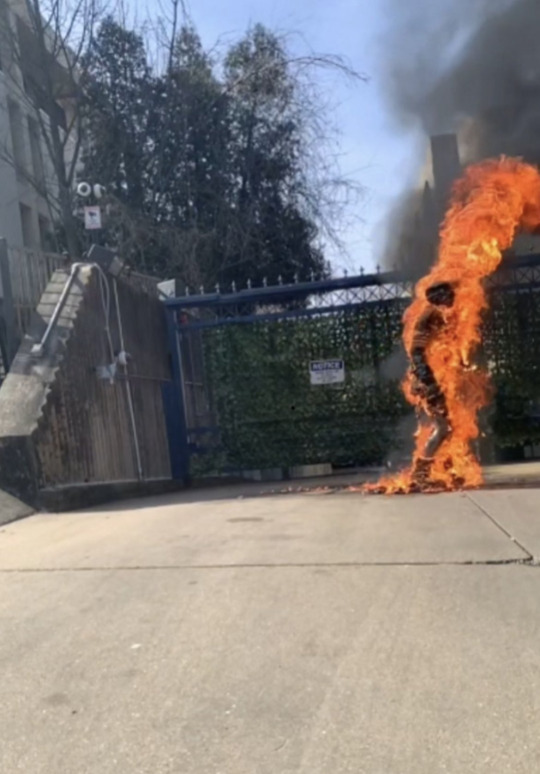
Aaron Bushnell: Self-Immolated in Front of the Israeli Embassy
Bushnell was a 25-year-old member of the U.S. Air Force stationed in San Antonio and originally from Cape Cod in Massachusetts. He joined the Air Force as an active-duty member in May 2020 and has since worked in information technology and development operations.
Hours before lighting himself on fire, Bushnell posted a Twitch link on his Facebook page with the caption:
Many of us like to ask ourselves, “What would I do if I was alive during slavery? Or the Jim Crow South? Or apartheid? What would I do if my country was committing genocide?” The answer is, you’re doing it. Right now.
Shortly before 1 p.m. on Sunday, Bushnell began his livestream and walked toward the Israeli Embassy with an insulated water bottle full of flammable fluid. “I will no longer be complicit in genocide,” he said in his video. “I am about to engage in an extreme act of protest. But compared to what people have been experiencing in Palestine at the hands of their colonizers, it’s not extreme at all. This is what our ruling class has decided will be normal.”
Bushnell then placed his phone on the ground and walked to the gates of the embassy, where he doused himself in liquid from the bottle. “Free Palestine,” he said, as he struggled to light himself. A law-enforcement officer approached, asking, “Can I help you, sir?” At this point, Bushnell lit himself on fire, screaming, “Free Palestine.”
As Bushnell screamed in pain, a law-enforcement officer off-camera yells at him to “get on the ground.” A second officer yelled at the first: “I don’t need guns, I need fire extinguishers.” By the time D.C. Fire and EMS arrived on the scene, the fire had been put out.
An incident report filed by a Secret Service agent states that they “received a distress call regarding an individual exhibiting signs of mental distress outside the Israeli embassy.” (The Secret Service is responsible for foreign-embassy security.) “Before the Secret Service officers could engage, [Bushnell] doused himself with an unidentified liquid and set himself on fire. The Secret Service officers promptly intervened, extinguishing the flames before the arrival of the fire department. [Bushnell] was subsequently transported to a local hospital due to the burns sustained from the incident. The report states that Bushnell was pronounced dead at 10:06 p.m. on Sunday.”
67 notes
·
View notes
Text
BEIRUT (Reuters) -A 21-year-old woman kidnapped by Islamic State militants in Iraq more than a decade ago was freed from Gaza this week in an operation involving the United States and Israel, officials said.
The rescue also involved Jordan and Iraq, according to officials.
The woman is a member of the ancient Yazidi religious minority mostly found in Iraq and Syria which saw more than 5,000 members killed and thousands more kidnapped in an IS campaign in 2014 that the U.N. has said constituted genocide.
She was freed after more than four months of efforts that involved several attempts that failed due to the difficult security situation resulting from Israel's military offensive in Gaza, Silwan Sinjaree, chief of staff of Iraq's foreign minister, told Reuters.
She has been identified as Fawzia Sido. Reuters could not reach the woman directly for comment.
Iraqi officials had been in contact with the woman for months and passed on her information to U.S. officials, who arranged for her exit from Gaza with the help of Israel, according to a source familiar with the matter.
The Israeli military said it had coordinated with the U.S. Embassy in Jerusalem and "other international actors" in the operation to free Sido.
It said in a statement her captor had been killed during the Gaza war, presumably by an Israeli strike, and she then fled to a hideout inside the Gaza Strip.
"In a complex operation coordinated between Israel, the United States, and other international actors, she was recently rescued in a secret mission from the Gaza Strip through the Kerem Shalom Crossing," it said.
After entering Israel, she continued on to Jordan through the Allenby Bridge Crossing and from there returned to her family in Iraq, the military said.
A State Department spokesperson said the United States on Tuesday "helped to safely evacuate from Gaza a young Yezidi woman to be reunited with her family in Iraq".
The spokesperson said she was kidnapped from her home in Iraq aged 11 and sold and trafficked to Gaza. Her captor was recently killed, allowing her to escape and seek repatriation, the spokesperson said.
TRAUMATIZED
Sinjaree said she was in good physical condition but was traumatized by her time in captivity and by the dire humanitarian situation in Gaza. She had since been reunited with family in northern Iraq, he added.
Iraqi Prime Minister Mohammed Shia al-Sudani had directly followed up on the issue with U.S. officials on the sidelines of the U.N. General Assembly in New York last month, according to Khalaf Sinjar, Sudani's advisor for Yazidi affairs.
More than 6,000 Yazidis were captured by Islamic State militants from Sinjar region in Iraq in 2014, with many sold into sexual slavery or trained as child soldiers and taken across borders, including to Turkey and Syria.
Over the years, more than 3,500 have been rescued or freed, according to Iraqi authorities, with some 2,600 still missing.
Many are feared dead but Yazidi activists say they believe hundreds are still alive. ______________________
Big question i have is why is a isis kidnapping victim being held in Gaza
22 notes
·
View notes
Text

Biden’s final days: Escalating aggression against Venezuela
By Lallan Schoenstein
After imposing genocidal policies that cost his party the U.S. election, President Joe Biden is filling out his final days of office with a slash-and-burn agenda that is even worse than the one he instigated before the elections.
In an outrageous attack on a sovereign country, the U.S. government is attempting to deny the Venezuelan people the leadership of their freely elected president, Nicolás Maduro. The Biden administration declared its belated recognition of Edmundo Gonzalez, the U.S.-funded candidate and big-time loser, in the July elections four months ago.
Biden waited until after the U.S. elections on Nov. 5 to more fully exercise his powers of “regime change” — a bid to overthrow a democratic election in Venezuela. Gonzalez is an old hand, a mercenary for the U.S. During the 1980s Contra war in Central America, Gonzales, operating from then-President C. A. Pérez’s Venezuelan embassy in El Salvador, was instrumental in running the covert U.S. counter-revolutionary campaign responsible for murdering thousands of Salvadorans.
#Venezuela#imperialism#antiwar#Nicolas Maduro#Genocide Joe#Joe Biden#Edmundo Gonzalez#contras#Latin America#Struggle La Lucha
13 notes
·
View notes
Text
Ukraine is set to face its toughest winter since the start of the full-scale invasion as Russia eyes cutting off its nuclear power after already bombing out capacity from half of its electricity generation sector in large-scale air strikes.
For now, Russia is not directly striking the plants with missiles and kamikaze drones. But Moscow has increasingly targeted nearby infrastructure, such as substations containing crucial equipment like transformers and power lines connecting nuclear plants to the grid.
“We're in a world where (Ukraine) has a deficit of functioning infrastructure. This is going to be the hardest winter yet,” International Energy Agency (IEA) Chief Economist Tim Gould told the Kyiv Independent.
If Russian attacks successfully disconnect all the power plants from the grid, then Ukraine’s only stable power source is gone, said Warsaw-based energy analyst Wojciech Jakobik.
“(Nuclear power) is a baseload capacity, which is irreplaceable by renewables, other sources, and especially not by energy imports,” he told the Kyiv Independent.
“With a smaller nuclear capacity in place, Ukraine will have less flexibility and less ability to stabilize (energy) generation.”
Ukraine has lost 9 gigawatts of power generation, including eight thermal plants and five hydro plants, due to Russian strikes this year. While companies scramble to repair their damaged assets, Russia is gearing up to attack Ukraine’s nuclear infrastructure, the Energy Ministry's press office told the Kyiv Independent, which would freeze out Ukrainians and cause a humanitarian crisis if the country can’t swiftly repair and protect its infrastructure.
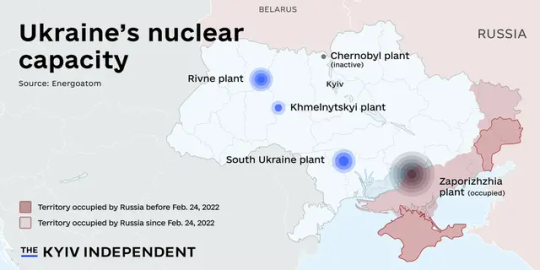
After the occupation of the Zaporizhzhia nuclear power plant in 2022, Ukraine relies heavily on three nuclear plants remaining under government control. They are the lifeline of the country, providing 60% of its power. The last mass attack on Aug. 26 forced Ukraine to disconnect three units at the Rivne and South Ukraine plants, causing weeks of power outages.
The country’s state-owned nuclear company, Energoatom, told the Kyiv Independent that all its power units are ready to operate at “maximum capacity” during the heating season, and the company connected a refurbished one-gigawatt nuclear power unit to the grid on Oct. 1. However, it has only recently announced plans to build additional fortifications to protect power plants from attacks.
Without stable power, Ukrainians will face another round of blackouts similar to the ones in the summer which could last as long as eight hours a day, according to Kyiv-based think tank DiXi Group. Brutally cold winter temperatures during power outages will freeze pipes, cutting off Ukrainians’ access to water and heating, and may lead to another wave of refugees, the UN’s refugee agency (UNHCR) told the Kyiv Independent.
At the same time, attacks on nuclear infrastructure massively heighten the risks of accidents, the Energy Ministry's press office said. While Jakobik believes a Chernobyl-like scenario is unlikely as reactors are well protected, damage to substations could prevent backup supplies of electricity that ensure the safety of reactors, according to the International Energy Agency (IEA).
The EU and the U.S. Embassy in Kyiv both told the Kyiv Independent that they are pitching in to bolster the energy sector in time for winter with financial support, backup equipment, and humanitarian aid. But with Russia relentlessly churning out and firing its missiles and drones, the only tangible tool for energy security is stronger air defense, the Energy Ministry's press office said.
Running out of time and options
During the first years of the full-scale invasion, Ukraine relied on different facilities within its massive energy sector to survive the initial attacks on energy infrastructure and even managed to export electricity to the EU. But that changed this year after mass attacks beginning in March wiped out 50% of its energy assets. Now, Ukraine has run out of options and switched from exporting to importing 2 gigawatts of electricity from its European neighbors. Winter power outages appear inevitable. The United Nations Human Rights Monitoring Mission (UNHRMM) expects blackouts to last between 4-18 hours a day, depending on attacks and the weather, causing living conditions to crumble for millions of citizens. “The deficit of electricity supply could be up to 6 gigawatts. That's the equivalent of peak demand in Denmark,” Gould said. With nuclear power as the remaining foundation for Ukraine’s energy stability, it is the prime target for Russian strikes, the Energy Ministry's press office said. Ukraine’s government seeks to decentralize the power grid as quickly as possible, but this is unlikely to happen by the winter and private energy companies are desperately restoring their assets to strengthen the grid.
Ukraine hopes to recover 3 gigawatts by the end of the year, said Olena Lapenko, general manager in the Field of Security and Resilience at DiXi Group. But this depends on critical funding, which state electricity grid operator Ukrenergo puts at $1.5 billion for rapid repairs this season. So far, Ukraine has received nearly 700 million euros ($766 million) from its energy support fund in cooperation with the European Commission, and winter is fast approaching.
Part of the fund covers much-needed equipment, such as autotransformers, to patch up facilities damaged by Russian air strikes as fast as possible. Simple repairs around nuclear plants, like power lines, can be fixed within 24 hours, said Jakobik. But specialized equipment depends on deliveries from Western allies, which can take months unless there are readily available stockpiles, he said. “The tough part is, you replace the old infrastructure with new parts and Russia attacks it once again,” he added. DTEK, Ukraine’s largest private energy company owned by its richest man Rinat Akhmetov, has lost 90% of its thermal plants capacity to Russian attacks. By winter, the company hopes to restore 60-65% of its thermal power that was damaged in spring. But even this would not be enough to replace nuclear power if all the plants are disconnected, said Oleksiy Povolotskiy, DTEK’s head of Recovery Office. Another issue, said Povolotskiy, is that the war has bitten a chunk out of Ukraine’s manual workforce while the scale of the damage is massive. DTEK is bringing in workers from other enterprises, like miners, to help clear debris. The company has asked European states to send engineers and machinery for more complex repairs.
The costs of Russian attacks are piling up for Ukraine. DTEK has already funneled $80 million into repairs from its own budget. Instead of relying on equipment that softens the fallout of attacks and power outages, Povolotskiy believes the most efficient solution is for Western allies to provide Ukraine with additional air-defense systems.
“Partners should understand that it is much cheaper and much more efficient to protect (energy facilities) than to repair,” he said.
The U.S. embassy in Ukraine told Kyiv Independent that the Defense Department will provide an additional Patriot battery and missiles but did not specify if this was directly for the protection of energy facilities. For now, this is the only confirmed delivery of an additional air defense battery, although Washington pledged a $2.6 billion aid package on Sept. 26 that includes munitions and support for air defense systems.
Ill prepared and ultra exposed
With no other extra air-defense systems currently in the pipeline, Ukraine’s government is building protective constructions for substations against falling debris and drones. However, not enough constructions have been built in time for winter and contractors have allegedly not been fully paid.
“More concrete constructions must be built as soon as possible,” Povolotskiy said.
Yuliia Kyian, an official at the Energy Ministry, told the Kyiv Independent during a discussion in Kyiv on Oct. 2, that the constructions are expensive and take time to build. They also cannot withstand ballistic missile strikes, she added.
Energoatom has faced criticism. In September and October, the company signed contracts to construct a $12.3 million shield around the Rivne Nuclear Power Plant and a $14.4 million worth of protection around the South Ukraine plant in Mykolaiv Oblast. Ukrainian anti-corruption watchdog Nashi Groshi reported that the contracts were concluded only after President Volodymyr Zelensky told the UN Security Council that Russia was preparing an attack on the three operating nuclear plants.
“It is difficult to assess why this was not done earlier,” said DiXi Group’s Lapenko. “Probably no one could imagine that the Russians would aim directly at the nuclear power sites as this is a serious threat to nuclear safety. But we can’t exclude such a scenario.”
A nuclear disaster would threaten the whole of Europe, the Energy Ministry's press office said, adding that the global community must unite to prevent a catastrophe. Kyiv has reached out to the UN’s nuclear agency (IAEA) to place more observation missions around its power plants, but an agreement has not yet been reached.
International observers will ensure that safety standards are enforced at the plants and combat disinformation, as Moscow frequently denies Ukraine’s accusations of endangering nuclear safety, Jakobik said. Nevertheless, Russia could pummel nuclear facilities to the point that it is dangerous for people to remain and force evacuations.
“Russia is not a responsible stakeholder in the nuclear sector,” he said.
“It's using energy terrorism against Ukraine. You cannot be sure about what Russia is doing,” the energy analyst added.
14 notes
·
View notes
Text
February 19, 2025
HEATHER COX RICHARDSON
FEB 20
The past week has solidified a sea change in American—and global—history.
A week ago, on Wednesday, February 12, Secretary of Defense Pete Hegseth announced at a meeting of the Ukraine Defense Contact Group in Brussels, Belgium, that President Donald Trump intended to back away from support for Ukraine in its fight to push back Russia’s invasions of 2014 and 2022.
Hegseth said that Trump wanted to negotiate peace with Russia, and he promptly threw on the table three key Russian demands. He said that it was “unrealistic” to think that Ukraine would get back all its land—essentially suggesting that Russia could keep Crimea, at least—and that the U.S. would not back Ukraine’s membership in the North Atlantic Treaty Organization (NATO), the mutual security agreement that has kept Russian incursions into Europe at bay since 1949.
Hegseth’s biggest concession to Russia, though, was his warning that “stark strategic realities prevent the United States of America from being primarily focused on the security of Europe.” Also on Wednesday, President Donald Trump spoke to Russia’s president, Vladimir Putin, for nearly an hour and a half and came out echoing Putin’s rationale for his attack on Ukraine. Trump’s social media account posted that the call had been “highly productive,” and said the two leaders would visit each other’s countries, offering a White House visit to Putin, who has been isolated from other nations since his attacks on Ukraine.
In a press conference on Thursday, the day after his speech in Brussels, Hegseth suggested again that the U.S. military did not have the resources to operate in more than one arena and was choosing to prioritize China rather than Europe, a suggestion that observers of the world’s most powerful military found ludicrous.
Then, on Friday, at the sixty-first Munich Security Conference, where the U.S. and allies and partners have come together to discuss security issues since 1963, Vice President J.D. Vance attacked the U.S.A.’s European allies. He warned that they were threatened not by Russia or China, but rather by “the threat from within,” by which he meant the democratic principles of equality before the law that right-wing ideologues believe weaken a nation by treating women and racial, religious, and gender minorities as equal to white Christian men. After Vance told Europe to “change course and take our shared civilization in a new direction,” he refused to meet with Germany’s chancellor Olaf Scholz and instead met with the leader of the far-right German political party that has been associated with neo-Nazis.
While the Munich conference was still underway, the Trump administration on Saturday announced it was sending a delegation to Saudi Arabia to begin peace talks with Russia. Ukrainian officials said they had not been informed and had no plans to attend. European negotiators were not invited either. When U.S. Secretary of State Marco Rubio and Russian foreign minister Sergei Lavrov spoke on Saturday, the Russian readout of the call suggested that Russia urgently needs relief from the economic sanctions that are crushing the Russian economy. The day before, Hungarian prime minister Viktor Orbán, an ally of both Putin and Trump, assured Hungarian state radio on Friday that Russia will be “reintegrated” into the world economy and the European energy system as soon as “the U.S. president comes and creates peace.”
Talks began yesterday in Riyadh, Saudi Arabia. In a four-and-a half-hour meeting, led by Rubio and Lavrov, and including national security advisor Mike Waltz, the U.S. and Russia agreed to restaff the embassies in each other’s countries, a key Russian goal as part of its plan to end its isolation. Lavrov blamed the Biden administration for previous “obstacles” to diplomatic efforts and told reporters that now that Trump is in power, he had “reason to believe that the American side has begun to better understand our position.”
Yesterday evening, from his Florida residence, Trump parroted Russian propaganda when he blamed Ukraine for the war that began when Russia invaded Ukraine’s sovereign territory. When reporters asked about the exclusion of Ukraine from the talks, Trump answered: “Today I heard, ‘Oh, well, we weren’t invited.’ Well, you've been there for three years. You should have ended it three years ago. You should have never started it. You could have made a deal.” He also said that Zelensky holds only a 4% approval rating, when in fact it is about 57%.
Today, Trump posted that Zelensky is a dictator and should hold elections, a demand Russia has made in hopes of installing a more pro-Russia government. As Laura Rozen pointed out in Diplomatic, former Russian president Dmitry Medvedev posted: “If you’d told me just three months ago that these were the words of the US President, I would have laughed out loud.”
“Be clear about what’s happening,” Sarah Longwell of The Bulwark posted. “Trump and his administration, and thus America, is siding with Putin and Russia against a United States ally.”
To be even clearer: under Trump, the United States is abandoning the post–World War II world it helped to build and then guaranteed for the past 80 years.
The struggle for Ukraine to maintain its sovereignty, independence, and territory has become a fight for the principles established by the United Nations, organized in the wake of World War II by the allied countries in that war, to establish international rules that would, as the U.N. charter said, prevent “the scourge of war, which twice in our lifetime has brought untold sorrow to mankind, and to reaffirm faith in fundamental human rights.” Central to those principles and rules was that members would not attack the “territorial integrity or political independence” of any other country. In 1949 the North Atlantic Treaty Organization (NATO) came together to hold back growing Soviet aggression under a pact that an attack on any of the member states would be considered an attack on all.
The principle of national sovereignty is being tested in Ukraine. After the breakup of the Soviet Union in 1991, Ukraine held about a third of the USSR’s nuclear weapons but gave them up in exchange for payments and security assurances from Russia, the United States, and the United Kingdom that they would respect Ukraine’s sovereignty within its existing borders. But Ukraine sits between Russia and Europe, and as Ukraine increasingly showed an inclination to turn toward Europe rather than Russia, Russian leader Putin worked to put his own puppets at the head of the Ukrainian government with the expectation that they would keep Ukraine, with its vast resources, tethered to Russia.
In 2004 it appeared that Russian-backed politician Viktor Yanukovych had won the presidency of Ukraine, but the election was so full of fraud, including the poisoning of a key rival who wanted to break ties with Russia and align Ukraine with Europe, that the U.S. government and other international observers did not recognize the election results. The Ukrainian government voided the election and called for a do-over.
To rehabilitate his image, Yanukovych turned to American political consultant Paul Manafort, who was already working for Russian billionaire Oleg Deripaska. With Manafort’s help, Yanukovych won the presidency in 2010 and began to turn Ukraine toward Russia. When Yanukovych suddenly reversed Ukraine’s course toward cooperation with the European Union and instead took a $3 billion loan from Russia, Ukrainian students protested. On February 18, 2014, after months of popular protests, Ukrainians ousted Yanukovych from power in the Maidan Revolution, also known as the Revolution of Dignity, and he fled to Russia.
Shortly after Yanukovych’s ouster, Russia invaded Ukraine’s Crimea and annexed it. The invasion prompted the United States and the European Union to impose economic sanctions on Russia and on specific Russian businesses and oligarchs, prohibiting them from doing business in U.S. territories. E.U. sanctions froze assets, banned goods from Crimea, and banned travel of certain Russians to Europe.
Yanukovych’s fall had left Manafort both without a patron and with about $17 million worth of debt to Deripaska. Back in the U.S., in 2016, television personality Donald Trump was running for the presidency, but his campaign was foundering. Manafort stepped in to help. He didn’t take a salary but reached out to Deripaska through one of his Ukrainian business partners, Konstantin Kilimnik, immediately after landing the job, asking him, “How do we use to get whole? Has OVD [Oleg Vladimirovich Deripaska] operation seen?”
Journalist Jim Rutenberg established that in 2016, Russian operatives presented Manafort a plan “for the creation of an autonomous republic in Ukraine’s east, giving Putin effective control of the country’s industrial heartland.” In exchange for weakening NATO and U.S. support for Ukraine, looking the other way as Russia took eastern Ukraine, and removing U.S. sanctions from Russian entities, Russian operatives were willing to help Trump win the White House. The Republican-dominated Senate Intelligence Committee in 2020 established that Manafort’s Ukrainian business partner Kilimnik, whom it described as a “Russian intelligence officer,” acted as a liaison between Manafort and Deripaska while Manafort ran Trump’s campaign.
Government officials knew that something was happening between the Trump campaign and Russia. By the end of July 2016, FBI director James Comey opened a counterintelligence investigation into Russian interference in the 2016 election. After Trump won, the FBI caught Trump national security advisor Lieutenant General Michael Flynn assuring Russian ambassador Sergey Kislyak that the new administration would change U.S. policy toward Russia. Shortly after Trump took office, Flynn had to resign, and Trump asked Comey to drop the investigation into Flynn. When Comey refused, Trump fired him. The next day, he told a Russian delegation he was hosting in the Oval Office: “I just fired the head of the F.B.I. He was crazy, a real nut job…. I faced great pressure because of Russia. That’s taken off.”
Trump swung U.S. policy toward Russia, but that swing hit him. In 2019, with the help of ally Rudy Giuliani, Trump planned to invite Ukraine’s pro-Russian president, Petro Poroshenko, to the White House to boost his chances of reelection. In exchange, Poroshenko would announce that he was investigating Hunter Biden for his work with Ukrainian energy company Burisma, thus weakening Trump’s chief rival, Democrat Joe Biden, in the 2020 presidential election.
But then, that April, voters in Ukraine elected Volodymyr Zelensky rather than Poroshenko. Trump withheld money Congress had appropriated for Ukraine’s defense against Russia and suggested he would release it only after Zelensky announced an investigation into Hunter Biden. That July 2019 phone call launched Trump’s first impeachment, which, after the Senate acquitted him in February 2020, launched in turn his revenge tour and then the Big Lie that he had won the 2020 election. The dramatic break from the democratic traditions of the United States when Trump and his cronies tried to overturn the results of the 2020 presidential election was in keeping with his increasing drift toward the political tactics of Russia.
When Biden took office, he and Secretary of State Antony Blinken worked feverishly to strengthen NATO and other U.S. alliances and partnerships. In February 2022, Putin launched another invasion of Ukraine, attempting a lightning strike to take the rich regions of the country for which his people had negotiated with Manafort in 2016. But rather than a quick victory, Putin found himself bogged down. Zelensky refused to leave the country and instead backed resistance, telling the Americans who offered to evacuate him, “The fight is here; I need ammunition, not a ride.” With the support of Biden and Blinken, NATO allies and other partners stood behind Ukraine to stop Putin from dismantling the postwar rules-based international order and spreading war further into Europe.
When he left office just a month ago, Biden said he was leaving the Trump administration with a “strong hand to play” in foreign policy, leaving it “an America with more friends and stronger alliances, whose adversaries are weaker and under pressure,” than when he took office.
Now, on the anniversary of the day the Ukrainian people ousted Victor Yanukovych in 2014—Putin is famous for launching attacks on anniversaries—the United States has turned its back on Ukraine and 80 years of peacetime alliances in favor of support for Vladimir Putin’s Russia. “We now have an alliance between a Russian president who wants to destroy Europe and an American president who also wants to destroy Europe,” a European diplomat said. “The transatlantic alliance is over.”
This shift appears to reflect the interests of Trump, rather than the American people. Trump’s vice president during his first term, Mike Pence, posted: “Mr. President, Ukraine did not ‘start’ this war. Russia launched an unprovoked and brutal invasion claiming hundreds of thousands of lives. The Road to Peace must be built on the Truth.” Senate Armed Services Committee chair Roger Wicker (R-MS) said, “Putin is a war criminal and should be in jail for the rest of his life, if not executed." Courtney Kube and Carol E. Lee of NBC News reported that intelligence officials and congressional officials told them that Putin feels “empowered” by Trump’s recent support and is not interested in negotiations; he is interested in controlling Ukraine.
A Quinnipiac poll released today shows that only 9% of Americans think we should trust Putin; 81% say we shouldn’t. For his part, Putin complained today that Trump was not moving fast enough against Europe and Ukraine.
In The Bulwark, Mark Hertling, who served as the Commanding General of the United States Army Europe, commanded the 1st Armored Division in Germany, and the Multinational Division-North in Iraq, underlined the dramatic shift in American alignment. In an article titled “We’re Negotiating with War Criminals,” he listed the crimes: nearly 20,000 Ukrainian children kidnapped and taken to Russia; the deliberate targeting of civilian infrastructure, including hospitals, schools, and energy facilities; the execution of prisoners of war; torture of detainees; sexual violence against Ukrainian civilians and detainees; starvation; forcing Ukrainians to join pro-Russian militias.
“And we are negotiating with them,” Hertling wrote. Josh Marshall of Talking Points Memo points out that the talks appear to be focused on new concessions for American companies in the Russian oil industry, including a deal for American companies to participate in Russian oil exploration in the Arctic.
For years, Putin has apparently believed that driving a wedge between the U.S. and Europe would make NATO collapse and permit Russian expansion. But it’s not clear that’s the only possible outcome. Ukraine’s Zelensky and the Ukrainians are not participating in the destruction of either their country or European alliances, of course. And European leaders are coming together to strengthen European defenses. Emergency meetings with 18 European countries and Canada have netted a promise to stand by Ukraine and protect Europe. “Russia poses an existential threat to Europeans,” President Emmanuel Macron of France said today. Also today, rather than dropping sanctions against Russia, European Union ambassadors approved new ones.
For his part, Trump appears to be leaning into his alliance with dictators. This afternoon, he posted on social media a statement about how he had killed New York City’s congestion pricing and “saved” Manhattan, adding “LONG LIVE THE KING!” White House deputy chief of staff Taylor Budowich reposted the statement with an image of Trump in the costume of an ancient king, with a crown and an ermine robe. Later, the White House itself shared an image that imitated a Time magazine cover with the word “Trump” in place of “Time,” a picture of Trump with a crown, and the words “LONG LIVE THE KING.”
The British tabloid The Daily Star interprets the changes in American politics differently. Its cover tomorrow features Vladimir Putin walking “PUTIN’S POODLE”: the president of the United States.
—
9 notes
·
View notes
Text
It’s only a matter of time before the supporters of Assad are rounded up and “prosecuted”.
Here’s a few headlines, the first describes events so far.
Syria – live: Israel fires more than 350 strikes against Syria as Mohammed al-Bashir appointed temporary PM
Here’s a report of US strikes:
Shockwaves in Syria – U.S. Targets Extremists After Regime Topples | RightWing
And another from a UK tabloid about the looting of the presidential palace, Iranian, Italian and Iraqi embassies and the central bank.
Syrian rebels loot banks, ransack Assad's millions & storm embassies after toppling tyrant as nation descends into chaos | The Sun
Lots of embedded videos and pictures in those articles.
Israel is going to establish a “sterile zone” beyond the Golan Heights whilst the US is poised to recognise the rebel leader, as he says that elections will be held by March 2025.
There is no mention of UK and EU military involvement.
No doubt tens of billions of dollars are on the way from NATO countries – starting with humanitarian aid to the areas that have been blown to bits.
There are estimates of a million displaced Syrians out of the country’s 22 million or so remaining people.
There is also no news of any Russian, Iranian, Iraqi or Turkish military operations. Neither is there any news about the activity of Kurds seeking to establish an autonomous region in the north of Syria.
Right now, the Israeli and US forces are acting with impunity and with no consequences for their actions.
I doubt this is the end of the conflict or its repercussions.
7 notes
·
View notes
Text
Alix Breeden at Daily Kos:
The State Department is considering closing 27 consulates and embassies across the world as part of the so-called Department of Government Efficiency’s budget cuts. According to an internal memo obtained by CNN, the department is also eyeing a move to pull resources from U.S. diplomatic missions in Somalia and Iraq, despite having ongoing counterterrorism efforts in both of those countries. A State Department spokesperson told Daily Kos that “operations continue as normal,” though they were not able to confirm nor deny the possibility of future closures. “The State Department continues to assess our global programs and posture to ensure we are best positioned to address modern challenges on behalf of the American people,” they told Daily Kos. In other words, nothing is off the table. Consulates are typically low-staffed agencies that provide help to Americans abroad with things like passports and visas. Even though Secretary of State Marco Rubio hasn’t publicly signed off on any closures yet, he has an interesting history with some of the countries who made the list.
The consideration of closing down several US Embassies is a colossal insult to common sense.
12 notes
·
View notes